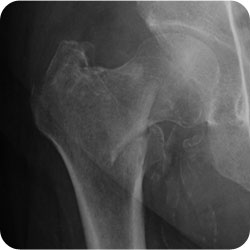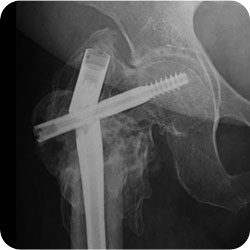Definition
- fractures from the extracapsular part of the neck to a point 5 cm distal to the lesser trochanter

Incidence
Aetiology
Anatomy
Classification
Boyd and Griffin Classification of Intertrochanteric Fractures
| Type | Description |
|---|---|
| 1 | Simple fracture that extend along the intertrochanteric line from the greater to the lesser trochanter |
| 2 | Comminuted fractures, the main fracture being along the intertrochanteric line, but with multiple fractures in the cortex |
| 3 | Fractures that are basically subtrochanteric with at least one fracture passing across the proximal end of the shaft just distal to or at the lesser trochanter. Varying degrees of comminution are associated. (reverse subtrochanteric) |
| 4 | Fractures of the trochanteric region and the proximal shaft, with fracture in at least two planes, one of which usually is the sagittal plane and may be difficult to see on routine anteroposterior radiographs |
Evans classification of intertrochanteric fractures based on direction of fracture
| Type | Description |
|---|---|
| I | Fracture line extends upward and outward from the lesser trochanter . Further subdivided . Stable . Unstable . Stability restored by anatomical reduction . Stability unrestored by anatomical reduction |
| II | reverse obliquity fracture, the major fracture line extends outward and downward from the lesser trochanter |
AO Classification of Trochanteric Fractures
| Group | Description |
|---|---|
| A1 | uncomminuted |
| A2 | increasing comminution |
| A3 | subtrochanteric extensions or reverse obliquity |
Pathology
History
Examination
Investigations
Xrays
Treatment
Nonoperative

Broken Gamma Nail
